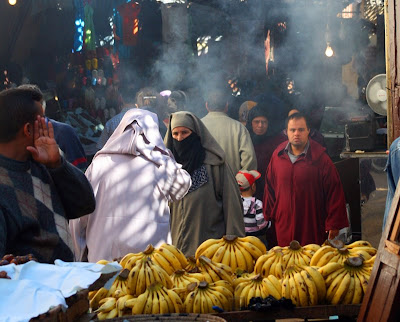"The courtyard becomes a place of repose, of refuge. In its tranquillity, its serenity, there is the sense of the divine, some echo of eternity." - Stanley Stewart

As regular readers will know, we post an occasional series of tributes or brickbats to travel writers who report back to the world on their experiences in Morocco. Today it is a tribute to an interesting article writen by Stanley Stewart in The Times Online. Stanley write evocatively about Fez and bravely suggests that Fez is "Marrakesh without the crowds". Here is an excerpt:There was a moment in the old medina in Fez, not far from the great gate known as the Bab Bou Jeloud, when three worlds seemed to collide - God, commerce and the Wolseley, in Piccadilly.
Here, within a few steps of one another, you find the religious, the secular and an excellent latte with lemon tart. Mammon is everywhere in these lanes, but God and the lemon tart would be all too easy to miss.
Fez is an extraordinary survivor. A medieval Muslim city, little changed in 1,000 years, it offers a vision of a world when the clash of civilisations involved Barbary pirates and white-slave traders.
Still enclosed within high walls, still threaded by a labyrinth of narrow alleys where mules jostle with robed figures, the medina is a whirlwind of buying and selling. If the intensity takes your breath away, it is not because there is more commerce than on Kensington High Street, but because in Fez everything is so brazenly public.
 Fez was the cultural centre of Morocco for 1,000 years or more, and as such it was home to numerous medersas, or Islamic universities. One of the more exquisite is the Bou Inania. Distracted by the chaos of the street, you could miss this miracle of medieval Islam. But you need to notice it. This is one of the reasons to come to Fez.
Fez was the cultural centre of Morocco for 1,000 years or more, and as such it was home to numerous medersas, or Islamic universities. One of the more exquisite is the Bou Inania. Distracted by the chaos of the street, you could miss this miracle of medieval Islam. But you need to notice it. This is one of the reasons to come to Fez.The Bou Inania is in retirement, its academic career over, which is why faithless characters such as myself are allowed in. It is one of the finest buildings in Morocco and ranks among the best in the Islamic world.
I came at lunchtime and was alone in the courtyard with a couple of white doves. I sat in a swathe of sun, my back to a warm wall. The courtyard is a space of the most exquisite proportions. Its interior walls bear three bands of dense decoration - zellij tiles, stucco work and cedar wood. The patterns – floral, geometric, calligraphic - are astonishingly intricate. They enclose the courtyard with an elaboration of design that is almost beyond measure, certainly beyond my comprehension. But the effect is not what you might expect.
Such busy design could well produce a claustrophobic sense of excess. In the courtyard of Bou Inania, however, one finds a wonderful calm. It is the ambition of Islamic art and architecture to illustrate the nature of God, so in all that movement, in all those curvaceous, swirling lines, there is a sense of stillness. And in the tremendous complexity of the designs, there is a wonderful simplicity. The courtyard becomes a place of repose, of refuge. In its tranquillity, its serenity, there is the sense of the divine, some echo of eternity.
Read the full article here: Fez: Marrakesh without the tourists. Check out our earlier travel writing stories:
Check out our earlier travel writing stories:Travel Writing Twenty-three
Travel Writing Twenty-two
Travel Writing Twenty-one
Travel Writing Twenty
Travel Writing Nineteen
Travel Writing Eighteen
Travel Writing Seventeen
Travel writing Sixteen.
Travel Writing Fifteen.
Travel Writing Fourteen.
Travel Writing Thirteen.
Travel Writing Twelve.
Travel Writing Eleven.
Travel Writing Ten.
Travel Writing Nine
Travel writing eight
Travel writing Seven
Travel Writing Six
Travel Writing Five
Travel Writing Four
Travel Writing Three
Travel Writing Two
Travel Writing One
Photographs: Sandy McCutcheon
Tags: Moroccan Morocco Fes, Maghreb news


No comments:
Post a Comment